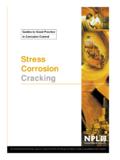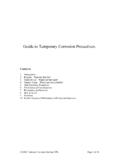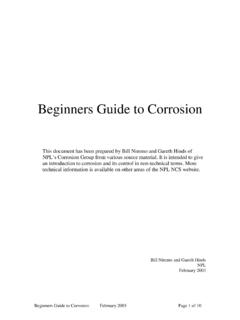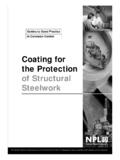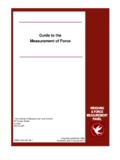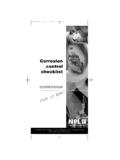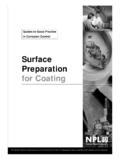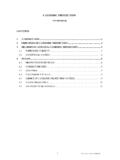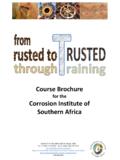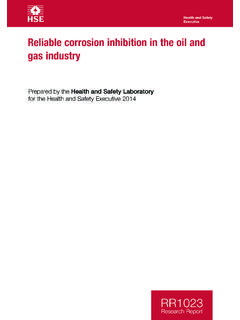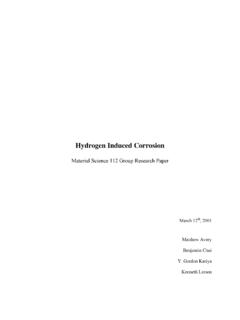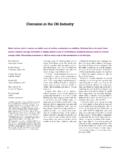Transcription of ATMOSPHERIC CORROSION - National Physical …
1 1 [ ATMOSPHERIC CORROSION /BM] ATMOSPHERIC CORROSION G O Lloyd ATMOSPHERIC CORROSION is not a very clearly defined subject. It occupies the territory between immersed CORROSION and dry oxidation, since metals may be exposed to damp atmospheres or may be subjected to the full force of the weather. It is usually taken to include packaging and storage, painting and preparation for painting, and the effects of climate and air purity. This contribution will concentrate mainly on CORROSION of iron and steel, with sideglances at other metals where necessary. Metals exposed to uncontrolled normal atmospheres may corrode more rapidly and by different mechanisms than those kept in pure, dry air even if they are not exposed to rain.
2 In dry atmospheres, the growing oxide film usually protects the underlying metal, giving rise to a logarithmic or square-root time law. In uncontrolled atmospheres, the rate usually remains constant for a period, but may fall off when the film has grown to an appreciable thickness. If the metal is exposed to rain, it may corrode while it is wet at the rate appropriate to immersion in impure, well-aerated water, but the rate will fall when it dries. Equations for predicting rates of ATMOSPHERIC CORROSION must therefore contain a term for time of wetness as well as for average temperature, average relative humidity, ATMOSPHERIC purity and so on. These equations are of limited value because it is almost impossible to specify the local conditions sufficiently precisely.
3 At ten sites within a few hundred metres of the promenade at Biarritz, rates of CORROSION of steel varied by an order of magnitude. The following rates for ingot iron were found by Ambler and Bain at Lagos, where there is a tropical surf beach. Approx Distance from surf (M) Salt content of air (mg NaCl/dm2) Rate of rusting (mm/year) 50 200 400 1300 25 miles - Average rates in the UK vary between mm/year at rural sites, mm/year at marine sites and up to mm/year in some industrial atmospheres.
4 In the driest atmospheres, 2 [ ATMOSPHERIC CORROSION /BM] at Khartoum, the rate can be as low as mm/year. Detailed results are often difficult to rationalise but in general it is clear that persistent wetness, high temperatures and contamination by strong electrolytes are responsible for the highest rates of CORROSION . Rates of rusting in impure controlled atmospheres without the complication of rain are low if the relative humidity is kept low, and remain fairly low even at 100% RH in the absence of strong electrolytes. The rate increases sharply at some RH in the region of 60-80% if the surface is contaminated with particles of sodium chloride, or ammonium sulphate, or if the atmosphere contains sulphur dioxide.
5 Vernon showed that there was an increase in rate at about 60% relative humidity even in pure air, and a further sharp increase at 80% in the presence of of sulphur dioxide. The increase was larger and the CORROSION product less protective if the surface was contaminated with particles of charcoal. More recent evidence suggests that the SO2 content in this work was unrealistically high, and that higher RH is needed to initiate rapid CORROSION with 1 ppm SO2 or less. In general, it seems that the critical relative humidity is set by the vapour pressure of some salt hydrate in the CORROSION product, and that chlorides and sulphates are the most effective corrosive agents. The effect of moist atmospheres is to set up droplets of some strong electrolyte with the classical pattern of CORROSION with a small anode in the centre of the drop acting as a source of ferrous ion and oxygen-reduction cathodes at the edges producing hydroxyl ion.
6 Such droplets become covered by a transparent skin, presumably of ferrous hydroxide, which darkens and thickens and eventually runs through the range of hydrated ferric oxides up to Goethite and lepidocrocite. According to ATMOSPHERIC conditions, these droplets may remain as discrete scabs, or may spread, or produce tracks that wander over the surface. When the rust layer is completed, the metal surface may become starved of oxygen, and it is quite common for a layer of Fe3O4 to form under the hydrated rust. The presence of corrosive salts will, however, prevent this layer from becoming very protective. Vernon showed that a carefully cleaned steel specimen would not rust even in a normal laboratory atmosphere if it was enclosed by muslin stretched over a wire frame.
7 The protective oxide film continued to develop, and if the specimen was removed from the 3 [ ATMOSPHERIC CORROSION /BM] enclosure after, say, a year, it would remain unaffected by dust particles, perhaps for several weeks, before spots of rust appeared. Other metals than iron and steel show rather similar phenomena on exposure to uncontrolled atmospheres. Copper produces a green film of CORROSION product containing hydrated sulphate, or carbonate, or chloride. It shows a rather similar variation of rates of CORROSION with relative humidity: rates are, however, much lower than for iron and steel, and copper sheeting on roofs has survived for well over 100 years.
8 Aluminium shows low rates of CORROSION in most circumstances, but may corrode rapidly when exposed to alkaline solutions of copper salts derived from copper roofing or from wood preservatives is also deleterious. Rates of CORROSION of completely exposed zinc are considerably lower than for iron and steel: the metal becomes covered with a protective layer of basic carbonate or basic sulphate. It may corrode comparatively rapidly if it is subjected to heavy condensation, or to high concentrations of sulphur dioxide. Nickel exposed to moist air containing sulphur dioxide becomes coated with a wet layer of nickel sulphate: nickel catalyses the oxidation of sulphur dioxide to sulphur trioxide. Silver is rapidly converted to the sulphide by hydrogen sulphide; this reaction is unusual in not being impeded by drying the air.
9 Stainless steels ( steels containing at least 12% chromium) show greatly improved resistance to ATMOSPHERIC CORROSION . The austenitic alloys containing 8% nickel and 18% chromium are still more resistant, and alloys containing in addition 2-3% molybdenum are almost completely unaffected by weathering in industrial atmospheres. Weathering or slow-rusting low-alloy steels containing copper with minor additions of other elements corrode at about 31 to the rate of plain steels. They have been used unprotected in some structures, but in rainy climates they tend to produce rainwater stains on other materials. Factors conducive to rusting of iron and steel are therefore: Sensible moisture High RH (above 70-80%) Salt mist Surface contaminants (dust, sweat residues, soldering fluxes, etc) 4 [ ATMOSPHERIC CORROSION /BM] ATMOSPHERIC contaminants (SO2, HCl, organic acids) High temperature.
10 Means of prevention include: Cleaning, and protection from dust Drying the atmosphere, and preventing condensation Purifying the atmosphere Use of CORROSION inhibitors Protective coatings (wrappings, temporary protective materials, paint films, surface coatings of metals, polymers or vitreous enamels, conversion coatings) Sacrificial coatings. Coatings If oxygen, water and strong electrolytes are required to produce rapid CORROSION , one or more of these agents may be excluded by a variety of coatings, ranging from noble metals and vitreous enamels through thick polymeric coatings ( polyethylene, nylon and PVC) and paint films to paper wrappings and thin coatings of polymer or greases. Metal films In principle, electrodeposits of metals might provide completely impervious barriers: gold, silver, nickel and chromium deposits are used both for decorative and for protective purposes.
